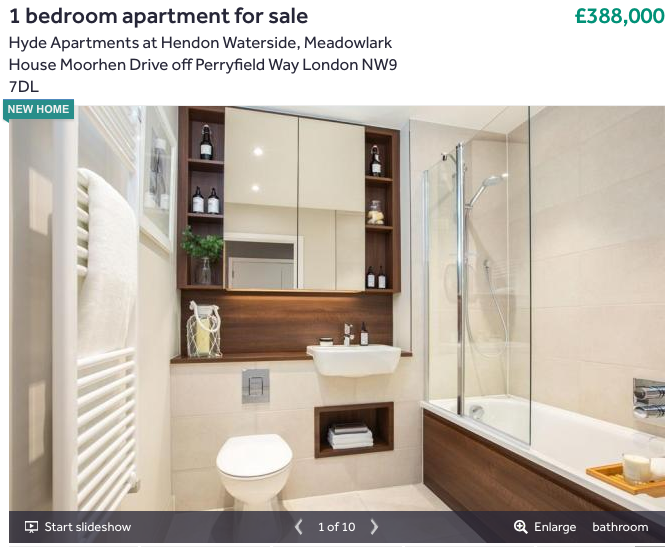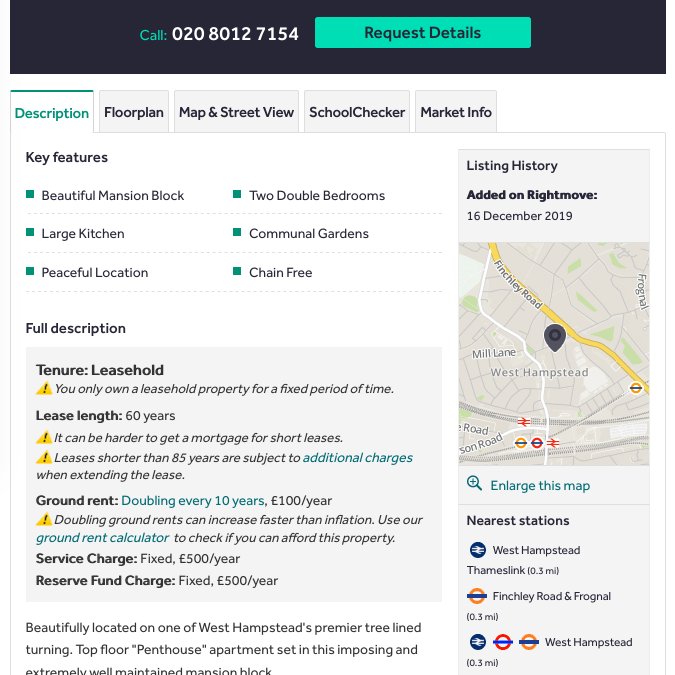The Terrible Lack of Transparency in Rightmove Ads for Leaseholds

Does £388,000 represent value for money for this flat? It’s impossible to tell because the listing omits basic information like tenure type, lease length, ground rent etc.
The Office of National Statistics numbers show that of 13,493 new builds sold in London in 2018, 94% were leaseholds. Rightmove, the online property portal currently enjoying a 76% marketshare has 5,335 new build properties for sale in London. The vast majority of these listings are placed by estate agents who are members of The Property Ombudsman — a government-approved scheme set up to protect buyers, sellers and tenants and which counts more than 95% of sales agents and 85% of letting agents in the UK as members. Paragraph 7i of their Code of Practice for Residential Estate Agents requires that:
The Consumer Protection from Unfair Trading Regulations 2008 require you to disclose any information of which you are aware or should be aware of in relation to the property in a clear, intelligible and timely fashion and to take all reasonable steps to ensure that all statements that you make about a property, whether oral, pictorial or written, are accurate and are not misleading. All material information must be disclosed and there must be no material omissions which may impact on the average consumer’s transactional decision. Where information is given to consumers and/or their representatives, it must be accurate and not misleading.
Where a transactional decision is defined to include “a buyer’s decision whether to view an advertised property” among other decisions a buyer might make. At the bottom of every Rightmove listing you will see the phrase “To view this property or request more details, contact:”, followed by the agent’s contact details. Of course estate agents on Rightmove want you to decide to view the property and get in touch with them — but what percentage of listings provide sufficient material information to make this important transactional decision?
Paragraph 7k of the Code of Practice helps define what material information is expected for leasehold properties:
In regard to leasehold properties, in accordance with paragraph 4e, you must provide material information to the consumer so they can make an informed transactional decision. Material information in respect of the lease includes, but is not limited to, the following:
- Number of years remaining on the lease;
- Amount of ground rent and when payable, together with details of how this will increase over time, if applicable;
- Rent payable in the case of a shared ownership arrangement;
For leasehold, commonhold and freehold properties where the owner has a legal obligation to contribute towards the maintenance costs of a shared amenity, material information would include, but is not limited to the following:
- Amount of service charge and wh en payable;
- Amount of any event fees, and when payable;
- Amount of reserve fund contribution and when payable (if not already included in other charges);
Today I made a quick script to download and analyse the most recent 1,041 listings for new builds in London on Rightmove to check just how forthcoming estate agents are with this information. Here’s what I found:
Of the 1,041 listings, 8% include the word “freehold”. This includes regular freeholds as well the approximately 2% of listings which include the words “share of freehold”. As approximately 94% of new build property sales in London in 2018 were leaseholds according to ONS stastics, it is reasonable to assume that the remaining 92% of listings that don’t contain the word “freehold” are leaseholds. As The Property Ombudsman Code of Practice states that you must provide material information to the consumer so they can make an informed transactional decision, we would expect these listings to include all the information required by the Code of Practice, including the fact that they are leaseholds as well as details such as lease length, ground rent and service charges. However, of these listings:
20% are missing TENURE TYPE
81% are missing YEARS REMAINING ON THE LEASE
87% are missing SERVICE CHARGE
93% are missing GROUND RENT
Estate agents will argue that buyers should do their own due diligence when buying leaseholds, but it is naive to expect buyers — especially if it’s their first time — to be aware of all the obligations they are taking on when signing a leasehold. The FCA has just reformed overdraft charges because “consumers cannot meaningfully compare or work out the cost of borrowing as a result of complex and opaque charges, that are both a result of and driver of poor competition.” As the myriad stories emerging from the leasehold scandal have shown, no charges levied on the general public are more complex or opaque than those commanded by property leases. And we desperately need to end the exploitative practice by developers of failing to reveal usurious leasehold terms until it’s too late for buyers to back out, and often after they have bought the property.
The Law Commision is working towards leasehold reform with its consultation on leasehold enfranchisement. But this will be a long process and well-connected, well-funded freeholders won’t give up without a fight. Solving the problem from the consumer education side might be a way to side-step the whole process: Improved transparency leads to more informed buyers leads to less appetite for leaseholds leads to reduced prices for leaseholds which hopefully leads to developers simply not selling them any more because they are no longer profitable.
PS. If you’re curious about my methodology or are interested in reporting on Rightmove and other property portals’ material information omissions — please get in touch!
Update: Here’s a quick mockup I made of what a Rightmove leasehold listing could look like if they had buyers’ interests in mind:
